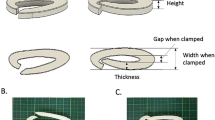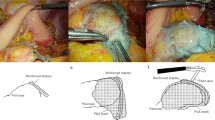Abstract
The aim of this study was to determine whether intraoperative Ankaferd blood stopper (ABS) application into the pancreatic channel and to the pancreatic remnant surface following distal pancreatectomy can or cannot prevent postoperative pancreatic fistula formation. Three pigs underwent distal pancreatectomy under general anesthesia. In two of the pigs, 0.5 ml of ABS was applied to the stump surface area after adding 0.5 ml of ABS into the pancreatic channel. The remaining one animal served as the control. The pigs were sacrificed on the seventh postoperative day for autopsy. The pancreatic remnants from the animals were then taken for histopathological analyses. It was observed that the oral intake had been broken and abdominal distention had developed in the control pig following on the third postoperative day. However, no significant clinical changes were observed in the ABS-applied pigs. In the autopsy, it was found that the control pig had generalized peritonitis with pancreatic necrosis. On the other hand, the ABS-applied pigs had either macroscopically and microscopically normal pancreatic tissue architecture with an occluded Wirsung duct at the pancreatic stump. It was concluded that application of ABS on the transected surface and into the pancreatic channel could prevent pancreatic fistula formation and improve wound healing in the residual pancreatic tissue following distal pancreatectomy.



Similar content being viewed by others
References
Cameron JL, Pitt HA, Yeo CJ et al (1993) One hundred and forty-five consecutive pancreaticoduodenectomies without mortality. Ann Surg 217:430–435
Büchler MW, Wagner M, Schmied BM et al (2003) Changes in morbidity after pancreatic resection: toward the end of completion pancreatectomy. Arch Surg 138:1310–1314
Shrikhande SV, Barreto G, Shukla PJ (2008) Pancreatic fistula after pancreaticoduodenectomy: the impact of a standardized technique of pancreaticojejunostomy. Langenbecks Arch Surg 393:87–91
Rodríguez JR, Germes SS, Pandharipande PV et al (2006) Implications and cost of pancreatic leak following distal pancreatic resection. Arch Surg 141:361–365
Kurt M, Oztas E, Kuran S et al (2009) Tandem oral, rectal, and nasal administrations of Ankaferd Blood Stopper to control profuse bleeding leading to hemodynamic instability. Am J Emerg Med 27:e631–e632
Kurt M, Disibeyaz S, Akdogan M et al (2008) Endoscopic application of ankaferd blood stopper as a novel experimental treatment modality for upper gastrointestinal bleeding: a case report. Am J Gastroenterol 103:2156–2158
Bilgili H, Captug O, Kosar A et al (2010) Oral systemic administration of Ankaferd blood stopper has no short-term toxicity in an in vivo rabbit experimental model. Clin Appl Thromb Hemost 16:533–536
Cipil HS, Kosar A, Kaya A et al (2009) In vivo hemostatic effect of the medicinal plant extract Ankaferd Blood Stopper in rats pretreated with warfarin. Clin Appl Thromb Hemost 15:270–276
Haznedaroglu BZ, Haznedaroglu IC, Walker SL et al (2010) Ultrastructural and morphological analyses of the in vitro and in vivo hemostatic effects of Ankaferd Blood Stopper. Clin Appl Thromb Hemost 16:446–453
Isler SC, Demircan S, Cakarer S et al (2010) Effects of medicanal plant extract Ankaferd Blood Stopper® on early bone healing. J Appl Oral Sci 18:409–414
Tasdelen FN, Tanriverdi CY, Coban AY et al (2009) Antimicrobial activity of plant extract Ankaferd Blood Stopper. Fitoterapia 80:48–50
Karaman K, Celep B, Bostanci EB et al (2010) Effects of Ankaferd Blood Stopper on pancreatic fluid: an in vitro study. ANZ J Surg 80:946–947
Kraft W, Dürr U (eds) (1995) Klinische Labordiagnostik in der Tiermedizin. Schattauer, Stuttgart, pp 122–123
Bilimoria MM, Cormier JN, Mun Y et al (2003) Pancreatic leak after left pancreatectomy is reduced following main pancreatic duct ligation. Br J Surg 90:190–196
Sheehan MK, Beck K, Creech S et al (2002) Distal pancreatectomy: does the method of closure influence fistula formation? Am Surg 68:264–267
Suzuki Y, Fujino Y, Tanioka Y et al (1999) Randomized clinical trial of ultrasonic dissector or conventional division in distal pancreatectomy for non-fibrotic pancreas. Br J Surg 86:608–611
Moriura S, Kimura A, Ikeda S et al (1995) Closure of the distal pancreatic stump with a seromuscular flap. Surg Today 25:992–994
Ohwada S, Ogawa T, Tanahashi Y et al (1998) Fibrin glue sandwich prevents pancreatic fistula following distal pancreatectomy. World J Surg 22:494–498
Li-Ling J, Irving M (2001) Somatostatin and octreotide in the prevention of postoperative pancreatic complications and the treatment of enterocutaneous pancreatic fistulas: a systematic review of randomized controlled trials. Br J Surg 88:190–199
Di Carlo V, Chiesa R, Pontiroli AE et al (1989) Pancreatoduodenectomy with occlusion of the residual stump by Neoprene injection. World J Surg 13:105–110
Haznedaroglu IC (2009) Molecular basis of the pleiotropic effects of Ankaferd Blood Stopper. IUBMB Life 61:290
Akar N, Demiralp DO, Haznedaroglu IC et al (2008) Functional proteomics of Ankaferd Blood Stopper. ASH Annu Meet Abstr 112:4103
Al B, Yildirim C, Cavdar M et al (2009) Effectiveness of Ankaferd blood stopper in the topical control of active bleeding due to cutaneous–subcutaneous incisions. Saudi Med J 30:1520–1525
Meric Teker A, Korkut AY, Kahya V et al (2010) Prospective, randomized, controlled clinical trial of Ankaferd Blood Stopper in patients with acute anterior epistaxis. Eur Arch Otorhinolaryngol 267:1377–1381
Teker AM, Korkut AY, Gedikli O et al (2009) Prospective, controlled clinical trial of Ankaferd Blood Stopper in children undergoing tonsillectomy. Int J Pediatr Otorhinolaryngol 73:1742–1745
Ibis M, Kurt M, Onal IK et al (2008) Successful management of bleeding due to solitary rectal ulcer via topical application of Ankaferd blood stopper. J Altern Complement Med 14:1073–1074
Kurt M, Kacar S, Onal IK et al (2008) Ankaferd Blood Stopper as an effective adjunctive hemostatic agent for the management of life-threatening arterial bleeding of the digestive tract. Endoscopy 40(Suppl 2):E262
Kurt M, Akdogan M, Onal IK et al (2010) Endoscopic topical application of Ankaferd Blood Stopper for neoplastic gastrointestinal bleeding: a retrospective analysis. Dig Liver Dis 42:196–199
Ozaslan E, Purnak T, Yildiz A et al (2009) The effect of Ankaferd blood stopper on severe radiation colitis. Endoscopy 41(Suppl 2):E321–E322
Tuncer I, Doganay L, Ozturk O (2010) Instant control of fundal variceal bleeding with a folkloric medicinal plant extract: Ankaferd Blood Stopper. Gastrointest Endosc 71:873–875
Shorbagi A, Sivri B (2010) Successful management of a difficult case of radiation proctopathy with Ankaferd BloodStopper: a novel indication (with video). Gastrointest Endosc 72:666–667
Kurt M, Onal I, Akdogan M et al (2010) Ankaferd Blood Stopper for controlling gastrointestinal bleeding due to distinct benign lesions refractory to conventional antihemorrhagic measures. Can J Gastroenterol 24:380–384
Ozaslan E, Purnak T, Yildiz A et al (2010) The effect of a new hemostatic agent for difficult cases of non-variceal gastrointestinal bleeding: Ankaferd blood stopper. Hepatogastroenterology 57:191–194
Karaman K, Bostanci EB, Ercan M et al (2010) Topical Ankaferd application to presacral bleeding due to total mesorectal excision in rectal carcinoma. J Invest Surg 23:175
Steer ML (2007) Exocrine pancreas. In: Townsend CM, Evers BM, Beauchamp RD, Mattox KL (eds) Sabiston textbook of surgery: the biological basis of modern surgical practice, 18th edn. Saunders, Philadelphia, pp 1589–1623
Author information
Authors and Affiliations
Corresponding author
Rights and permissions
About this article
Cite this article
Karaman, K., Bostanci, E.B., Celep, B. et al. In Vivo Healing Effects of Ankaferd Blood Stopper on the Residual Pancreatic Tissue in a Swine Model of Distal Pancreatectomy. Indian J Surg 77, 176–181 (2015). https://doi.org/10.1007/s12262-013-0828-1
Received:
Accepted:
Published:
Issue Date:
DOI: https://doi.org/10.1007/s12262-013-0828-1




